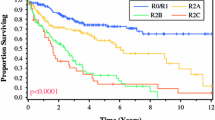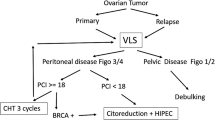Abstract
Introduction: In the past, peritoneal carcinomatosis, regardless of primary tumor type, has always been a lethal condition. Recently, special treatments using cytoreductive surgery with peritonectomy procedures combined with perioperative intraperitoneal chemotherapy have resulted in long-term survival. Appendiceal malignancy with a low incidence of liver and lymph node metastases may be especially appropriate for these aggressive local regional treatments.
Methods: All patients treated with surgery before January 1999 are included. Patients left with gross residual disease after surgery were not given intraperitoneal chemotherapy, but were later treated with intravenous chemotherapy. The intraperitoneal chemotherapy was given in the perioperative period, starting with mitomycin C at 12.5 mg/m2 for males and 10 mg/m2 for females. For patients whose pathology showed adenomucinosis, intraperitoneal chemotherapy was limited to treatment in the operating theater with heated mitomycin C. Patients with mucinous adenocarcinoma or pseudomyxoma/adenocarcinoma hybrid had, in addition to mitomycin C, five consecutive days of intraperitoneal 5-fluorouracil at 650 mg/m2 instilled in 1–1.5 liters of 1.5% dextrose peritoneal dialysis solution. A complete cytoreduction was defined as tumor nodules <2.5 mm in diameter remaining after surgery. The histopathology categorized the patients as having adenomucinosis, adenomucinosis/carcinomatosis hybrid, or mucinous carcinomatosis. A previous surgical score was used to estimate the extent of previous surgical procedures.
Results: The morbidity of treated patients was 27% and the mortality was 2.7%. In a multivariate analysis, prognostic factors for survival included the completeness of cytoreduction (P < .0001), the histopathological character of the appendix malignancy (P < .0001), and the extent of previous surgical interventions (P = .001). Patients with a complete cytoreduction and adenomucinosis by pathology had a 5-year survival of 86%; with hybrid pathology, survival at 5 years was 50%. Incomplete cytoreduction had a 5-year survival of 20% and 0% at 10 years.
Conclusions: Cytoreductive surgery and perioperative intraperitoneal chemotherapy can be used to salvage selected patients with peritoneal surface spread of appendiceal primary tumors. Similar strategies for other patients with peritoneal surface malignancy such as peritoneal carcinomatosis from colon or gastric cancer, peritoneal sarcomatosis, or peritoneal mesothelioma should be pursued.
Similar content being viewed by others
REFERENCES
Sugarbaker PH. Observations concerning cancer spread within the peritoneal cavity and concepts supporting an ordered pathophysiology. Cancer Treat Res 1995;82:79–99.
Sugarbaker PH. Pseudomyxoma peritonei: A cancer whose biology is characterized by a redistribution phenomenon. Ann Surg 1994;219:109–111.
Sugarbaker PH. Peritonectomy procedures. Ann Surg 1995;221:29–42.
Sugarbaker PH. Laser-mode electrosurgery. In: Sugarbaker PH, ed. Peritoneal carcinomatosis: Diagnosis and treatment. Boston: Kluwer Academic, 1996:375–385.
Sugarbaker PH. Intraperitoneal chemotherapy and cytoreductive surgery: Manual for physicians and nurses. 3rd edn. Grand Rapids, MI: Ludann, 1998.
Sugarbaker PH, Chang D, Koslowe P. Peritoneal carcinomatosis from appendiceal cancer: A paradigm for treatment of abdominopelvic dissemination of gastrointestinal malignancy. Acta Chir Austriaca 1996;28:4–8.
Jacquet P, Sugarbaker PH. Current methodologies for clinical assessment of patients with peritoneal carcinomatosis. J Exp Clin Cancer Res 1996;15:49–58.
Ronnett BM, Shmookler BM, Sugarbaker PH, Kurman RJ. Pseudomyxoma peritonei: New concepts in diagnosis, origin, nomenclature, relationship to mucinous borderline (low malignant potential) tumors of the ovary. Anatomic pathology. Chicago: American Society of Clinical Pathologists Press, 1997:197–226.
Stephens AD, Alderman R, Chang D, Edwards GD, Esquivel J, Sebbag G, Steves MA, Sugarbaker PH. Morbidity and mortality of 200 treatments with cytoreductive surgery and hyperthermic intraoperative intraperitoneal chemotherapy using the coliseum technique. Ann Surg Oncol 1999;6:790–796.
Author information
Authors and Affiliations
Rights and permissions
About this article
Cite this article
Sugarbaker, P.H., Chang, D. Results of Treatment of 385 Patients With Peritoneal Surface Spread of Appendiceal Malignancy. Ann Surg Oncol 6, 727–731 (1999). https://doi.org/10.1007/s10434-999-0727-7
Received:
Accepted:
Issue Date:
DOI: https://doi.org/10.1007/s10434-999-0727-7




